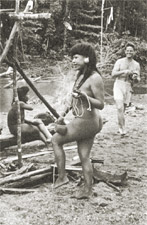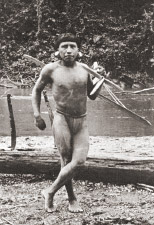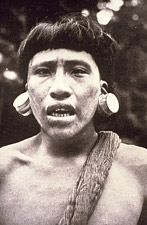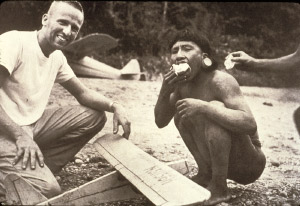 |
|
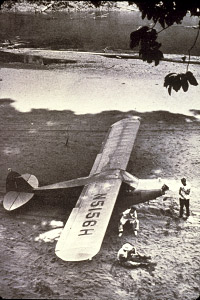 |
|
On the 3rd. January 1956, Nate Saint started ferrying his companions, Jim Elliott, Pete Fleming, Ed McCully, and Roger Youderian, and their survival equipment in his yellow Piper aircraft to the planned landing spot. The aircraft had been modified by installing a larger engine, more powerful brakes and a number of safety features; it had been ideal for the gift drops because of its ability to fly in circles at a low speed. The first landing was something of an experiment; Nate could not be sure that the sand would be firm enough to support the weight of the aircraft, but he came in on his final approach low and slow, and on touch down the extra large tyres worked well. It took many flights from the airstrip at Arajuno to 'Palm Beach' to ferry everyone and everything, but on the last flight, Nate circled low over the Waorani house before landing, to encourage them to come to visit them. Finally assembled at Palm Beach, they made a camp, with a tree house for extra security at night and they settled down to wait.
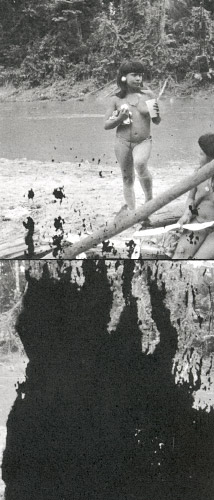 |
|
They waited for three days until on the 6th. January three Waorani: Naenkiwi, a man of about thirty; Dayuma's teenage sister Gimari; and her aunt Mintaka; walked the four miles from the house to the riverbank where the aeroplane had landed. After initial greetings, Naenkiwi indicated, by drawing in the sand, that he wanted a ride in the plane, so Nate flew him over his house. The following day, Naenkiwi and Gimari went home. Naenkiwi, embroiled in personal tensions of his own making, concerning his relationship with Gimari, lied to the others that the missionaries had tried to kill them, that they were cannibals, and that they had also killed Dayuma. As a result, five Waorani men: Gikita, Dyuwe, Minkaye, Kimo and Nimonga plotted to kill the missionaries and made spears. On the afternoon of the 8th. January, the Indians attacked; the five missionaries were speared to death, and their bodies left by the river. Dayuma's brother Nampa was hit in the head by a bullet from one of the missionary's pistols, and died much later.
After the spearing of the five Americans, which made world headlines, Dayuma heard about yet more killings among her people. She wanted to do something to stop these senseless acts, but she was afraid that, after living with outsiders for nearly ten years, her people might even kill her if she returned. But, two years after the terrible spearing at Palm Beach, some of her relatives came out of the forest looking for her and persuaded her to go back. So Dayuma returned to her people on the Tewaeno river, where she heard of her brother's death and found her people decimated by violent revenge killings, weary of the spearings and living in fear. Relieved and surprised to find Dayuma still alive after living with outsiders, her Waorani relatives listened to her stories about her cowode friends and saw an opportunity for change, an escape from a life of endless fear.
Through Dayuma, the Waorani invited Rachel Saint and Elisabeth Elliott, one a sister and one a widow of the speared missionaries, to come to live with them. The invitation was accepted, and when the two American women travelled to the forest, the first ever peaceful contact with the Waorani was made. Rachel Saint and Elisabeth Elliott settled into a life with the killers of their loved ones and began to convert them to Christianity.
It has often been stated that the spearing of the five missionaries was the turning point in Waorani history. But the truly pivotal point was when Rachel and Elisabeth showed the Waorani that they were ready to forgive them for the killings. Forgiveness was a new concept to them, and it brought, for the first time ever, a possibility of peace, something the Waorani had longed for and sought for many generations, but had failed to attain. The appeal of the Christian message for the Waorani had more to do with the promise of an end to living in constant fear of spearing raids than any promise of an afterlife or relationship with God.
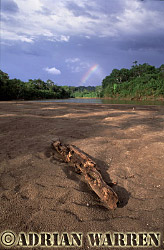 |
"Palm Beach", rio Curaray, Ecuador, 2002
site of 1956 Missionary killings |
Rachel had been asked by the oil companies to persuade the Waorani to move from their scattered settlements to one place, to allow exploration to continue unimpeded. . The moves would be for their own safety, since ultimately the exploration would be unstoppable. Little by little, more and more Waorani families arrived to settle at the newly founded sanctuary at Tewaeno, seeking a new life without the constant fear of being killed. They persuaded the Waorani to build an airstrip so they could get in and out of Tewaeno without the arduous trip by trail. During the 1960s, as they moved out of the old hunting grounds and made way for oil exploration, raids and killings among the Waorani reduced. The area surrounding the village of Tewaeno became officially established as a protectorate for the Waorani by 1968. It was not a prison, however, and those who did settle there were free to come and go. Some of them did just that.
In addition to acting as the catalyst for the cessation of killing, the missionaries served as a model for interaction with cowode. Because the missionaries attempted to identify with Waorani needs, the Waorani responded positively to the missionaries early on, but learned later that not all cowode intended to treat them so well. Some cowode wanted their land or its resources, others wanted cheap labour, and yet others wanted sexual access to their women. It took time for the Waorani to realise that not all cowode would treat them as well as they had come to expect from the missionaries.
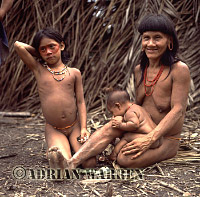 |
| Use of ACHIOTE for decoration, rio Cononaco, Ecuador, 1983 |
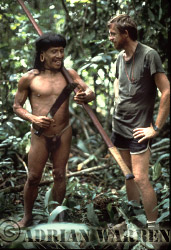 |
Caempaede and Jim Yost, 1983 |
Some Waorani preferred to remain in the old hunting grounds, in spite of the fact that spearing raids continued between the different communities. Following a particularly vicious raid, one of the groups, led by a Waorani called Tagae, in fear of reprisals and for their own safety, fled. They began to live in self imposed isolation, and killed anyone who approached them including their own close relatives, believing it was safer that way than to risk reprisals. As time passed their anxiety, and their notoriety, increased. During the sixties, eleven attacks by Tagae's group resulted in the deaths of twenty outsiders. Meanwhile, among other isolated groups still living traditionally, the old fears and deep hostilities lingered on. One of these groups, living on the Gabado river, included a man called Caempaede.
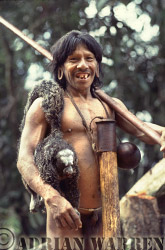 |
Caempaede after a successful hunt, 1983 |
Tonyae, a Wao* living at Tewaeno, was related to Caempaede, and went to contact the group at Gabado in an effort to persuade them to come to live in peace with others at the protectorate. When Tonyae arrived,
Caempaede's group seemed to accept him; and, in preparation for contact with outsiders, they even help Tonyae cut an airstrip, but then Caempaede's group grew nervous. They killed Tonyae with an axe, and then fled the area, fearing reprisals. When Tonyae did not return to Tewaeno, Rachel Saint and Dayuma flew over the area around Gabado, calling to Caempaede's group through a loudspeaker fixed on to the aircraft. Some of the group were persuaded that it would be safe to meet them at the new airstrip that had been cut with Tonyae. This peaceful meeting paved the way for more regular contact, and it was then that Jim Yost, a young American anthropologist working under the auspices of a missionary organisation called the Summer Institute of Linguistics, first met Caempaede and the rest of his community. It was the beginning of a long relationship for Jim and the Waorani, based on a growing friendship and trust.
* "Waorani" is plural. "Wao" is the singular form; also, when used as an adjective, it is usually Wao house, Wao language etc.
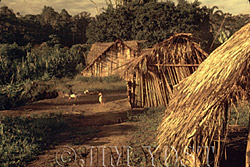 |
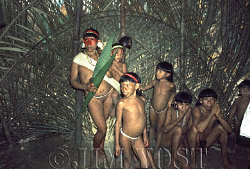 |
Tewaeno, 1973: Housing styles have varied in Waorani culture since pre-contact times |
Gabado, 1974:
Visitors from Dicado show up at the Gabado aemae |




